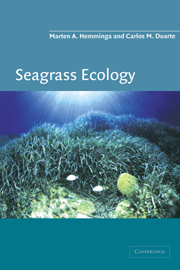6 - Fauna associated with seagrass systems
Published online by Cambridge University Press: 29 September 2009
Summary
Introduction
The meadows formed by seagrasses have characteristics that make them a suitable habitat for many species of animals. The high primary productivity of the seagrasses, augmented with that of epiphytic and benthic algae, ensures an abundant supply of organic matter that can be used as the basic energy source for more or less complicated food webs. Moreover, the three-dimensional structure of the vegetation, with its network of roots and rhizomes and often dense leaf canopy, offers hiding places that protect against predation, and also provides substrate for attachment. The vegetation structure, furthermore, confers physical and chemical qualities to the environment that may attract fauna: currents within the canopy are reduced, the sediment is stabilized and often fine grained, and irradiance conditions are modified. In this chapter we will first take a closer look at the general abundance and species richness of the fauna associated with seagrass meadows, before turning to the faunal groups that have received major attention, i.e. fishes, crustaceans and molluscs. The association of sea cows and turtles with seagrass beds will also be discussed. The significance of seagrass meadows as a habitat and foraging area is a recurrent theme in these sections. In the final part of the chapter, the ways in which the fauna affect the functioning of the seagrasses will be addressed.
Abundance and diversity
The fauna of seagrass meadows are heterogeneous assemblages of animals belonging to a variety of taxa, with many different ecological characteristics.
- Type
- Chapter
- Information
- Seagrass Ecology , pp. 199 - 247Publisher: Cambridge University PressPrint publication year: 2000
- 6
- Cited by



